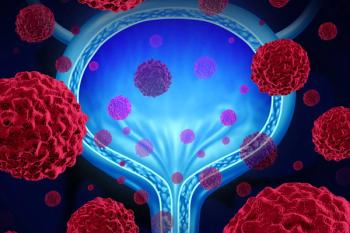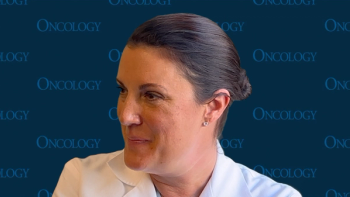
Bemarituzumab Regimen Improves Survival in FGFR2b+ Gastric/GEJ Cancer
Investigators will present detailed results from the phase 3 FORTITUDE-101 trial at a future medical meeting.
Combining bemarituzumab with leucovorin calcium, fluorouracil, and oxaliplatin (mFOLFOX6) as frontline therapy demonstrated a statistically significant and clinically meaningful overall survival (OS) improvement vs placebo plus mFOLFOX6 among patients with unresectable locally advanced or metastatic gastric or gastroesophageal junction (GEJ) cancer harboring FGFR2b overexpression, according to a press release on prespecified interim analysis findings from the phase 3 FORTITUDE-101 trial (NCT05052801).1
Data showed that the bemarituzumab combination met the trial’s primary end point of OS among patients with FGFR2b overexpression defined by 2+ or 3+ staining in at least 10% of tumor cells per immunohistochemistry (IHC) testing.
The most common treatment-emergent adverse effects (TEAEs) observed in the bemarituzumab arm included reduced visual acuity, punctate keratitis, neutropenia, nausea, anemia, corneal epithelium defect, and dry eye. Ocular toxicities in the FORTITUDE-101 trial appeared to be comparable with phase 2 reports across both study arms, although they were more frequent and severe among patients who received bemarituzumab in the phase 3 portion.
Investigators plan to share detailed results from the FORTITUDE-101 trial at a medical meeting in the future.
“Most patients with gastric cancer are diagnosed at an advanced stage, with poor prognosis, low survival rates, and limited therapeutic options,” Jay Bradner, MD, executive vice president of Research and Development at Amgen, the developers of bemarituzumab, stated in the press release.1 “These first positive top-line results of an FGFR2b-targeted monoclonal antibody from our phase 3 FORTITUDE-101 study mark a meaningful advance in the development of effective targeted therapy for gastric cancer.”
Investigators of the multi-center, double-blind, placebo-controlled FORTITUDE-101 trial assessed bemarituzumab plus mFOLFOX6 vs placebo plus mFOLFOX6 in the front-line setting for patients with advanced gastric or GEJ cancer harboring FGFR2b overexpression. Patients in the experimental arm of the study received bemarituzumab via intravenous infusion.2
The trial’s primary end point was OS in patients with FGFR2b expressed in at least 10% of tumor cells with 2+ or 3+ staining intensity per IHC. Secondary end points included progression-free survival, objective response rate, duration of response, disease control rate, quality of life per European Organization for the Research and Treatment of Cancer Quality of Life Questionnaire responses, maximum observed concentration of bemarituzumab, and TEAEs.
Patients 18 to 100 years old with histologically documented unresectable, locally advanced or metastatic gastric or GEJ cancer not amenable to curative therapy harboring FGFR2b expression in 10% or more of tumor cells with 2+ or 3+ tumor cell staining per centrally performed IHC testing were eligible for enrollment on the trial. Other eligibility criteria included having an ECOG performance status of 0 or 1, measurable or evaluable non-measurable disease per RECIST v1.1 guidelines, and no contraindications to treatment with mFOLFOX6. Patients were also required to have adequate organ and bone marrow function.
Those with prior treatment for metastatic or unresectable disease, prior therapy targeting the FGF-FGFR pathway, known HER2 positivity, or untreated or symptomatic central nervous system disease or metastases were ineligible for enrollment on the trial.
Previously, the China Center for Drug Evaluation of the National Medical Products Administration granted breakthrough therapy designation to bemarituzumab as a treatment for patients with FGFR2b-positive gastric and GEJ adenocarcinoma.3
“Bemarituzumab is the first FGFR2b inhibitor to demonstrate a statistically and clinically significant overall survival benefit in a randomized phase 3 trial for the first-line treatment of FGFR2b-positive gastric cancer. The success of the global phase 3 FORTITUDE-101 study highlights the potential of bemarituzumab to redefine the standard of care for a patient population that has [experienced] poor outcomes with existing therapies,” Rafael Amado, MD, president, head of Global Research and Development at Zai Lab, who holds co-development and commercialization rights for bemarituzumab for mainland China, Hong Kong, Macau, and Taiwan, said regarding the study findings.3 “Based on these results, and the regulatory breakthrough designation, we plan to move rapidly toward regulatory submission in China to bring this transformative therapy to patients as quickly as possible.”
References
- Amgen announces positive topline phase 3 results for bemarituzumab in fibroblast growth factor receptor 2b (FGFR2b) positive first-line gastric cancer. News release. Amgen. June 30, 2025. Accessed July 1, 2025. https://tinyurl.com/76krm2e5
- Bemarituzumab or placebo plus chemotherapy in gastric cancers with fibroblast growth factor receptor 2b (FGFR2b) overexpression (FORTITUDE-101). ClinicalTrials.gov. Updated February 7, 2025. Accessed July 1, 2025. https://tinyurl.com/25wuwzwy
- Zai Lab announces positive topline phase 3 results for bemarituzumab in fibroblast growth factor receptor 2b (FGFR2b) positive first-line gastric cancer. News release. Zai Lab Limited. June 30, 2025. Accessed July 1, 2025. https://tinyurl.com/nahft2ys
Newsletter
Stay up to date on recent advances in the multidisciplinary approach to cancer.


















































































